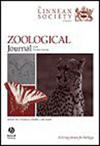跗猴毛状附着结构的进化与系统发育的再评价(异翅目:跗猴科:跗猴科)
IF 2.8
2区 生物学
Q1 ZOOLOGY
引用次数: 0
摘要
全世界共有24属147种。本文将Castro-Huertas和Melo(2023)的形态数据集中新增的分类群和性状整合为一个由181个性状组成的新数据集,并对该数据集进行了进化分析,其中包括63个终端,包括18个属(75%的属多样性),49个Saicini种和12个外群。该植物为单系植物,其姊妹种为卡拉onia orientalis (Visayanocorini)。我们的假设在赛奇尼中发现了两个主要的分支,我们认为这两个分支是两个新的亚部落:赛奇纳亚部落。11月和塔加利纳子。11月;和新的部落,萨奇瑞提部落。11 .在Emesinae内不确定的亲缘关系。此外,还探讨了内镜的形态和进化。镫骨是位于第三跗体上的一种毛状附着结构,由一组匙形刚毛组成,存在于所有的猴腿上,也存在于Emesini和Leistarchini (Emesinae)部落的一些物种的中腿和中腿上。所有腿上都有Scopula,这是Saicini部落的近亲。对毛状刚毛的祖先状态的重建表明,这种结构出现在Saicini的前跗骨第三节的腹侧区域,其祖先没有鼻镜。鼻镜的排列与发现的支枝一致。本文章由计算机程序翻译,如有差异,请以英文原文为准。
Reassessment of the Saicini phylogeny and evolution of hairy attachment structures on tarsi (Heteroptera: Reduviidae: Emesinae)
Saicini comprise 24 genera and 147 species worldwide. Here, we include additional taxa and characters to the morphological dataset of Castro-Huertas and Melo (2023) into a new one composed of 181 characters, which was analysed cladistically with 63 terminals, comprising 18 genera (75% of the generic diversity), 49 species of Saicini, and 12 outgroups. Saicini was recovered as monophyletic, with Carayonia orientalis (Visayanocorini) as its sister-species. Our hypotheses recovered two main clades within Saicini that we recognized as two new subtribes: Saicina subtrib. nov. and Tagalina subtrib. nov.; and the new tribe, Saiciretini trib. nov. of uncertain affinities within Emesinae. Additionally, the morphology and evolution of the scopula is explored. The scopula is a hairy attachment structure on the third tarsomere composed of a set of spatulate setae present on all legs of Saicini and on the meso- and metalegs of a few species of the tribes Emesini and Leistarchini (Emesinae). Scopula presence on all legs had been recovered as synapomorphy of the tribe Saicini. The reconstruction of the ancestral state of the hairy setae shows an emergence of this structure on the ventral region of the third tarsal segment of the protarsus in Saicini and its ancestor without scopula. The arrangement of the scopula is consistent with the recovered clades.
求助全文
通过发布文献求助,成功后即可免费获取论文全文。
去求助
来源期刊
CiteScore
6.50
自引率
10.70%
发文量
116
审稿时长
6-12 weeks
期刊介绍:
The Zoological Journal of the Linnean Society publishes papers on systematic and evolutionary zoology and comparative, functional and other studies where relevant to these areas. Studies of extinct as well as living animals are included. Reviews are also published; these may be invited by the Editorial Board, but uninvited reviews may also be considered. The Zoological Journal also has a wide circulation amongst zoologists and although narrowly specialized papers are not excluded, potential authors should bear that readership in mind.

 求助内容:
求助内容: 应助结果提醒方式:
应助结果提醒方式:


